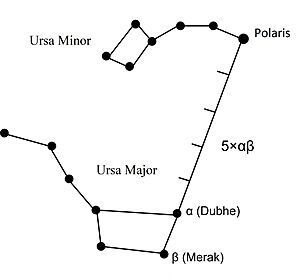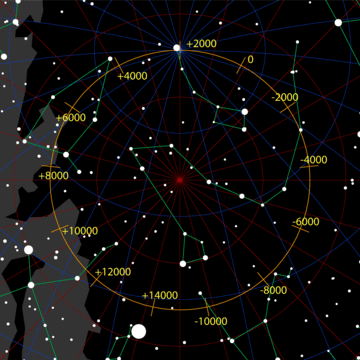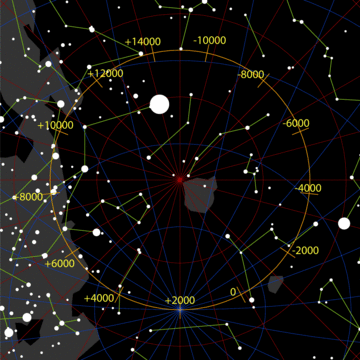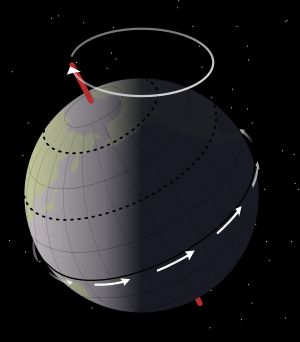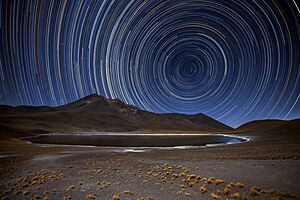Pole star facts for kids
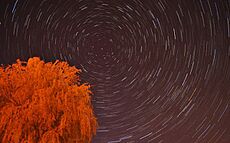
A pole star is a special star that seems to stay in almost the same spot in the sky. This happens because it lines up with the spinning axis of a planet, like Earth. Imagine a line going straight through the Earth from the North Pole to the South Pole. A pole star would be right along that imaginary line, far out in space.
For Earth, we have a North Pole Star and a South Pole Star. Our current North Pole Star is Polaris. It's a bright star that helps sailors and explorers find their way. Our South Pole Star is Polaris Australis, but it's much fainter and harder to see.
Long ago, around 1700 BC to 300 AD, two other stars, Kochab and Pherkad, were the North Pole Stars. But they weren't as close to the pole as Polaris is today.
Contents
How Pole Stars Change Over Time
The Earth's axis doesn't always point to the exact same spot in space. It slowly wobbles, like a spinning top that's slowing down. This wobble is called precession. Because of this wobble, different stars become our pole stars over thousands of years.
Right now, Polaris is very close to Earth's North Celestial Pole. This means it appears almost directly north in the sky. It will be closest to the pole around the year 2100.
Thousands of years ago, other stars were the North Star. Around 3000 BC, a faint star called Thuban in the Draco constellation was the North Star. It was very close to the pole, but it was much dimmer than Polaris.
Later, around 1000 BC, Kochab was the brightest star near the pole. However, it was never as close as Polaris is now. The ancient Greeks even said that the pole had no bright star.
The Earth's wobble takes about 25,770 years to complete one full cycle. This means the North Star changes over a very long time.
Future North Pole Stars
After Polaris, the North Celestial Pole will slowly move towards stars in the Cepheus constellation.
- Around 4200 AD, Gamma Cephei (called Errai) will be the closest star to the North Pole.
- Later, around 7500 AD, Alpha Cephei (Alderamin) will take its turn.
Then, the pole will point towards stars in the Cygnus constellation.
- Around 11,250 AD, Delta Cygni will be a helpful pole star.
- Even later, around 14,500 AD, Vega, a very bright star in the Lyra constellation, will become the North Star. It was also the North Star about 12,000 BC.
Eventually, the pole will move towards stars in the Hercules constellation, like Tau Herculis around 18,400 AD. After that, it will return to the Draco constellation (where Thuban was) before coming back to Ursa Minor and Polaris again around 27,800 AD.
Not every star that lines up with the pole is bright enough to be a good "North Star." Sometimes, there won't be a very bright star directly at the pole, making it harder to find north.
Southern Pole Star
Unlike the North Pole, there isn't a bright South Pole Star like Polaris. The closest star to the South Celestial Pole is Sigma Octantis. But it's very dim, so it's hard to see without a telescope, especially if there's light pollution.
Instead, people in the Southern Hemisphere often use the Southern Cross constellation to find the South Pole. It points to where the South Pole Star would be.
If you are at the equator, you can see both Polaris (the North Star) and the Southern Cross!
Just like the North Pole, the South Celestial Pole also moves. In the future, it will pass close to other stars like Gamma Chamaeleontis and Omega Carinae. Much, much later, around 66,270 AD, the very bright star Sirius will become a South Pole Star!
Pole Stars on Other Planets
Each planet in our solar system has its own pole stars. This is because their axes of rotation (the imaginary line they spin around) point in different directions.
- Mercury: Its North Pole Star is Omicron Draconis, and its South Pole Star is Alpha Pictoris.
- Venus: 42 Draconis is near its north pole, and Eta1 Doradus is near its south pole. Venus spins almost upside down!
- Moon: Our Moon's North Pole Star is Omicron Draconis, and its South Pole Star is Delta Doradus.
- Mars: Kappa Velorum is close to its south pole. For its north pole, the top two stars of the Northern Cross (Sadr and Deneb) point the way.
- Jupiter: Its north pole is near Zeta Draconis, and its south pole is near Delta Doradus.
- Saturn: Delta Octantis is its South Pole Star. Its north pole is in the Cepheus constellation, not far from Polaris.
- Uranus: Eta Ophiuchi is its North Pole Star, and 15 Orionis is its South Pole Star.
- Neptune: Its north pole points between Gamma and Delta Cygni. Its South Pole Star is Gamma Velorum.
Pole Stars in Culture and Stories
In olden times, Polaris was often called stella maris, which means "star of the sea." This was because sailors used it to navigate their ships across the ocean. It was a reliable guide that always stayed in the same spot in the northern sky.
Many cultures and religions have special meanings for the pole star. For example, in some traditions, Polaris was linked to the Virgin Mary, seen as a guiding light. In Mandaean cosmology, the Pole Star is a very important symbol of the "World of Light" or heaven. People praying in this faith face north, and their temples are built facing north too.
Images for kids
-
The North Star pictured in the coat of arms of Utsjoki
See also
- Celestial equator
- Direction determination
- Guide star
- Lists of stars


